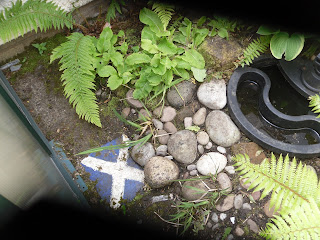Well, better weather today! A bit blowy with a few showers
but fine for gardening.
We had lots of jobs to do.
The alpine strawberries had arrived to plant in the
courtyard – so Mrs Morrison and two of us did that. We also put the plant stand
onto a “runabout” - a round platform on wheels – so that the stand could be
turned round regularly to allow the sun to shine on all sides of the stand and
ripen all the fruit – not just the plants facing south.
Mr Morrison had put up a net along the fence for the sweet
peas. So Mrs Whyte and Mrs Thomson re-dug the border and put in some edging. Then
some of us helped to plant the sweet peas we had started off in toilet roll
middles – one plant for each section of the net. They need something to support
them as they grow; so we can put the wee tendrils round the net and help them
climb up.
In another bit of the border, Miss McKenzie helped us to
plant the “Russian Giant” sunflowers that we had started off in February and
then hardened off in the coldframe – one for each paling on the fence so we can
tie them up as they grow. We hope they will grow to about 2.5 metres with big flowers
at the top.
The daffodils were pretty much past so Miss McKenzie helped
us to dead head them (taking off the dead heads to allow the plants to put all
their efforts into making the bulbs big and healthy ready to produce next year’s
flowers. Otherwise they would put all their efforts into making seeds under the
flower heads).
Then we weeded the bed and put lily bulbs into the middle. They
were planted about 5-6 cms down to give the stems some support when they grow.
The boys stapled the signs to the posts at each bed.
And then we had to plant the seeds. Mrs Morrison showed us
how to sow them. First of all we had to make sure the earth was nice and level
– no lumps and bumps – and we did that with our hands. Then we laid a hoe over
the bed to give a nice straight line (we could have used a string if the bed
had been wider) and made a wee “drill” using another hoe. A “drill” is like a
very shallow ditch. Then the seeds go in – just a very few sprinkled in evenly.
Then we covered the drill over with a wee bit of earth.
We planted carrots (maybe we put in a few too many because
we used a whole packet for four wee rows!), white turnip, golden ball turnip,
radish, lettuce and spring onion.
Then there were the peas and broad beans we had started off
earlier in the year and hardened off in the coldframe.
For the beans there was a frame of canes with strings across
them. We planted one bean plant beside each string so we could wind them round
the strings as they grow and support them, since the stems are not really quite
strong enough to take the weight of the leaves and the beans. We got a bit
mixed up with the beans, the peas and the sunflowers but they really look quite
different! Hope we’ve got them right in the end!
For the peas there was a frame of canes with netting over
the top. We put one pea plant beside each section of netting and they will
clamber up the net and get support.
Finally the potatoes. We planted then two weeks ago and
guess what? They are showing through the ground! So Mrs Whyte showed us how to
“earth” them up. We pulled earth in from each side of the rows of potatoes to
make wee mounds. That makes sure the potatoes that grow near the surface are
well covered. If they are not they will go green and not be so good to use. We
will probably have to earth up again later.
Last of all we planted a new honeysuckle which is really
perfumed (the previous one had vanished), a winter flowering jasmine (flowers
early in the year) and a clematis (very showy flowers) against the fence – they
should make a lovely show.




















































